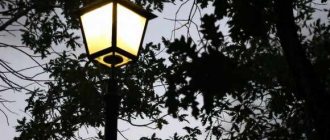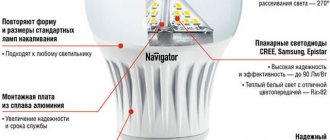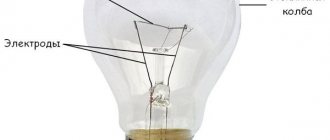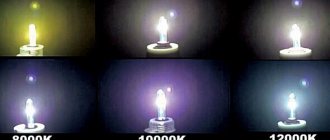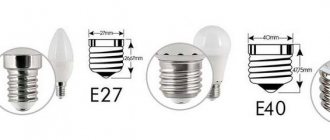In connection with the popularization of LED light sources, potential buyers have questions related to the quality of the product. Unfortunately, in retail, many sellers cannot give complete answers based solely on packaging data. The manufacturer, in turn, finds it beneficial to indicate only “marketing” characteristics on the product packaging.
The value of such a technical parameter as pulsation coefficient is not usually given in the description. Many Chinese manufacturers don't even standardize it. However, the negative impact of pulsating lighting has been scientifically proven and normatively enshrined in Russian standards. Should we focus on this physical phenomenon when choosing LED lamps? What danger does increased flicker pose to humans?
Definition and unit of measurement
The pulsation coefficient (Kp) is one of the characteristics that determines the quality of artificial lighting. To calculate Kp, the illumination level is measured and the minimum, average and maximum values are recorded. The data is then plugged into the formula below.
The pulsation coefficient of LED lamps is a dimensionless quantity. For ease of understanding, the obtained result is displayed in percentage equivalent. Using this formula, calculations are made based on measurements of harmonic vibrations. LED lamp drivers are a source of negative harmonic signals, which simplifies experimental measurements.
If there is pulsed noise in the radiation source, more complex calculations are used. However, this has nothing to do with the electrical circuits of LED lamp power supplies.
How to check pulsation?
It should be noted right away that, firstly, flickering of the lamp is possible only when it is connected to the AC power supply. When powered by a battery or batteries, LED lamps operate without ripples (Kp = 0%). Secondly, it is impossible to measure pulsation using available means (video or camera). With their help, you can only quench your curiosity and make sure that there is flicker.
According to GOST R 54945–2012, the pulsation of LED lamps must be measured with special devices with measuring radiation transducers. The document lists a number of instruments recommended for measurements:
- Multichannel radiometer "Argus";
- Pulse meter-lux meter “Argus 07” or “TKA-PKM”/08;
- Pulse meter-lux meter “TKA-PKM”/08;
- Luxmeter-brightness meter-pulse meter “Ecolight-01” or “Ecolight-02”.
Externally, these measuring instruments are slightly larger than a remote control and are equipped with photo sensors, a display and control buttons. As a rule, the device can be connected to a PC, and visualization and additional calculations can be organized using an application program.
SanPiN 2.2.1/2.1.1.1278–03 and SP 52.1333.2011
In Russia, requirements for lighting quality are regulated by regulatory documents. In particular, SanPiN 2.2.1/2.1.1.1278–03 establishes hygienic requirements for lighting in residential and public buildings. In living rooms, LED lamps must provide an illumination level of at least 150 Lux. The pulsation coefficient is not standardized. In public non-industrial buildings, sanitary standards set the Kp value within 10-20%.
In the set of rules SP 52.1333.2011, much attention is paid to the standards of artificial lighting of all types of structures, residential areas and production sites. The regulatory document separately stipulates the requirements for LED light sources. Depending on the degree of work intensity, it shows the permissible values of the pulsation coefficient and illumination.
Ripple Ratio Details
The main reason for flickering is the ripple factor. This is a dimensionless quantity, which is expressed as a percentage and reflects the level of illumination fluctuations when the luminous flux varies. The light source is the base that connects to alternating current.
Thanks to the research, it turned out that at a 10% pulsation coefficient, a stroboscopic effect appears, and this is an optical illusion. It appears due to incorrect perception of objects that are in motion. There are standards for the permissible value of the pulsation coefficient. The value should be between 5% and 20% depending on the circumstances under which visual work occurs.
In those places where there are the most people, the coefficient cannot exceed:
- Preschool children's institutions - 10%.
- Places where computers are located – 5%.
- Educational institutions – 10%.
- Places where high-precision work is carried out – 10%.
The pulsation factor can also occur in manufacturing plants, as well as in warehouse hangars, that is, in places where people can only be for some time, and where the possibility of a stroboscopic effect is excluded. However, the first factor can lead to a dangerous situation, for example, the rotation of the part may coincide with the flickering of the lamp. In such a situation, the part will appear to be in a stationary position, and because of this, a dangerous situation may arise that will lead to industrial injuries.
Such standards were established recently, and only recently have they begun to be closely monitored for compliance. In most enterprises, as well as in educational institutions, lighting does not meet sanitary standards. Therefore, as a result of inspections, everyone began to improve the quality of lighting.
Negative impact
Visible pulsations of light flux with a frequency of up to 80 Hz have a negative effect on the brain and irritate the nervous system through the organs of vision. As a result, a person is subconsciously forced to deal with discomfort and wants to quickly leave the area affected by the flickering light. Pulsating light lighting can also lead to actual work-related injuries. For example, if the rotation speed of a circular saw matches the frequency of the luminous flux of an LED lamp, it may seem to a person that the machine is not moving. Situations like these are serious causes of workplace injuries.
Flicker in the range of 80–300 Hz is not directly perceptible to the human eye. However, visual receptors detect these vibrations, which provoke disruptions in the functioning of the brain. Acting unnoticed, they gradually shift hormonal levels, contribute to a decrease in performance, and worsen emotional well-being. As experiments have shown, prolonged exposure to light flux pulsations contributes to the emergence and exacerbation of chronic diseases of the nervous system.
The effect of light pulsations on the body and brain
If you delve deeper into this issue, you will find that not all pulsations are equally harmful. Some of them can even be ignored and not measured.
For the first time, the process of the influence of light pulsations on the human body was described in detail in the journal “Svetotekhnika” back in 1963. Summarizing the material presented in it, we can draw some conclusions.
For example, light pulsations with a frequency of up to 300 Hz really have a negative effect on our body.
With constant exposure to such light, the usual daily rhythm and general hormonal levels change. When flickering at a frequency of up to 120 Hz, our brain reacts to this “flickering” and tries to perceive non-existent information, processing it and loading itself. It is quite natural that this directly affects fatigue.
Here is a visual experiment and the results of an EEG of the brain. In the first case (Figure A), the person is sitting in a darkened room, and in the second (Figure B), he is in a room with pulsating lamps with a frequency of 120 Hz.
Look at abnormal peaks of activity and imagine how this affects your biorhythms and your overall well-being.
But if these pulsations have a frequency above 300 Hz, then they are simply not recorded in any way by the human body and brain.
And accordingly, they do not have any influence on him.
How to remove pulsation in an LED lamp?
Many LED lamps of Chinese origin are equipped with a primitive power supply unit (PSU), which cannot be called a driver. It consists of an RC circuit, a diode bridge and a low-capacitance filter capacitor, no more than 10 μF. It is precisely because of the lack of a high-quality smoothing filter that the constant voltage at the output pulsates with a frequency of less than 300 Hz. Below is a diagram of such a lamp.
The quality of the output signal can be improved by replacing the electrolytic capacitor with an analogue of larger capacity. As a result, the amplitude of the variable component of the signal will decrease several times. However, this is not always possible due to the large size of the capacitor required.
The main requirements for the driver are to provide the lamp LEDs with a stable current and the miniature dimensions necessary to place the circuit inside the base. Therefore, the most reliable way to significantly reduce the ripple factor is to replace a low-quality power supply with a driver with a built-in PWM controller.
If, for subjective reasons, it is not possible to get rid of the harmful flickering of an LED lamp, then it is recommended to install it in a room with the least number of switches on. When planning your next purchase of an LED lamp, make a choice in favor of certified products from well-known brands.
How to check a light bulb for pulsation - traditional methods
The simplest and most common household methods for checking pulsations include the following methods:
- mobile phone
Just look at the light from a light bulb through your smartphone screen. What is not visible to your eye will be very noticeable on camera.
However, keep in mind that some devices have built-in forced flicker reduction capabilities. Therefore, you may not see anything, although the effect will be present.
You need to bring it as close as possible so that the filament or diffuser takes up as much of the entire screen space as possible.
- camera
Take a photo of the light bulb without flash. If there are dark stripes on it, this is a sign of flickering.
- pencil method
Hold a pencil or ruler up to the light bulb and start flicking it like a fan or fan.
If the effect of “frozen blades” appears or you see several pencils, then the pulsation is greater than normal.
The clearer the outlines, the higher the coefficient. Such residual contours of figures due to light flickering appear in everyday life.
- spinning top
Spin the spinning top under a light source. If a stroboscopic effect appears, change the light bulbs.
However, similar folk methods detect pulsation up to 100 Hz. But from 100Hz to 300Hz, they can fail. Therefore, you should not rely on them.



